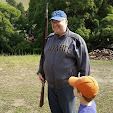I am not a photography expert at all, but I have come up with a decent process for photographing completed miniatures. I try to get as accurate an image as I can: no tricks, no hiding flaws. I don't want any of my clients to get a nasty surprise when they unpack their figures, and I don't want any blog viewers to have an inaccurate idea of what is possible with 15mm (or smaller!) miniatures.
My photography lighting is the same Ott Light I use for painting. A single sheet of folded printer paper is my only backdrop. I bought a Nikon Coolpix L120 back in 2012. It's simple enough for me to figure out, and it takes excellent photos. I set the white balance manually, and I keep the ISO at 100. This results in very slow shutter speed, so I use the timer feature along with a small tripod to keep the camera steady.
I use a free photo editor, IrfanView, to crop and resize the raw images. I keep a copy of each image on my hard drive, sorted into folders by commission. This, along with my written notes, allows me to match colors if a client wants additions to their forces.
I upload the cropped images into another editor, Picasa 3, for fine tuning. I adjust the fill light, highlights, and shadows until the image matches the colors I see on my desk.
Once the photography is complete, I make my blog post and alert my client. Hey John, there are more pictures of your troops!

















So concludes this most interesting series of posts Scott. It's always good to see other people's technique, the similarities and differences. You achieve a fine result with yours.
ReplyDeleteYou seem to have the photography worked out really well too. As I have been told by photographers, lighting is the key.
Regards, James
This has been a great series. Thank you for showing how you produce your amazing figures.
ReplyDeleteAre you still taking commissions?
Regards,
Dave
Thanks for this it shows the worth of preparation. Sean
ReplyDelete